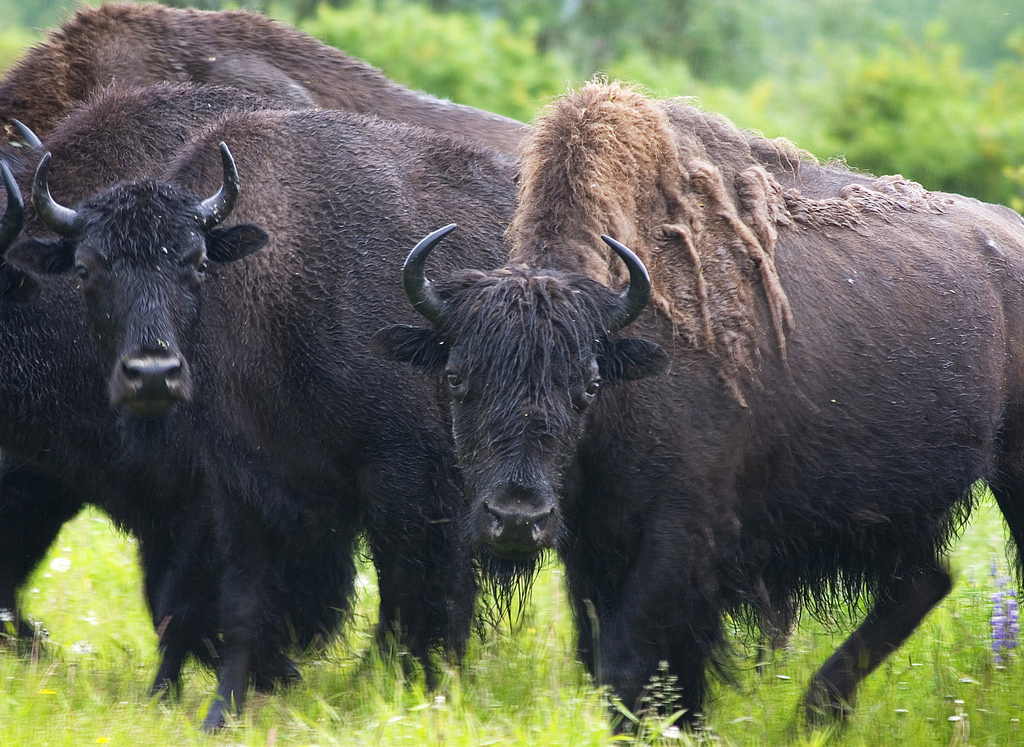
The American bison is one of several big game animals in Alaska. The bison was transplanted to Alaska from Montana in 1928, after becoming almost extinct in America. Twenty of these animals were delivered to an area around Delta Junction and by 1985 the population had grown to approximately 700.
The bison is a spectacular animal in size, measuring six feet at the shoulders, almost ten feet long, and weighing over a ton. The head and front quarters are the largest part of the body, making this section look out of proportion to the hind quarters, which are smaller.
The bison sheds its coat in the spring of the year after winter is over. Then, in the fall, it grows its winter coat, which is a rich, dark brown color. The coat changes color during the winter and by spring is a lighter color. Bison bulls have large, heavy horns that curve upward. Cows’ horns are lighter and not as large.
Calves are born anytime from May to August and at first have a brownish-red coat. At ten weeks old, this brownish-red coat starts to darken and about five weeks later, turns to a dark brown color. They are very active almost immediately after birth, being able to run and kick their hind legs up in the air about three hours after birth. They also begin grazing at an early age – about six days old. They will stay with their mother, following her until the next spring, when they are about a year old before they venture out on their own.
These animals are natural grazing animals, but in Alaska, their food is only found along rivers and areas where fires have burnt old vegetation growth and created fresh foliage. They eat various types of grass, also silverberry, willow, and ground birch. Since Alaskan winters are extremely severe, it can be hard for the bison to survive. Their thick layers of hair and plenty of stored fat are an advantage to them in surviving the cold winds and temperatures. Strong winter winds tend to benefit the bison, as the winds will blow the snow, preventing it from accumulating and becoming too deep. The healthy bison usually survives the winters.
They migrate to a winter range in the northwest around Farewell Lake, where there are many small rivers and ponds with vegetation available for them to eat. They can smell food beneath deep snow and they use their huge bodies to push the snow away to get to the food.
Bison hunts have to be controlled to prevent the population from overburdening the limited range areas. Hunting bison is a challenge, as stalking them is difficult; and bringing them down also is quite a feat. They are the hardest of all Alaska’s big game to bring down. Their meat tastes much like beef and is delicious to eat.
Bears and wolves are predators of bison calves but usually do not have much luck, as the adult bison will fight to protect the calves. All predators will leave adult bison alone, because of their size, which intimidates them, and their large horns, which they use to fight with, and can easily kill another animal. They are second only to the black bear for viciousness towards any threatening creature.
Approximately sixty million bison roamed the Great Plains from Mexico to Canada and north into Alaska up until the nineteen century. Then came the insurgence of settlers crossing the United States. They killed thousands of bison mainly for their hides. Before this, the Plains Indians depended on bison for their food and hides. The Indians used the hides to make their clothes, their tents, etc. The bison had a great economical value for the Indians.
